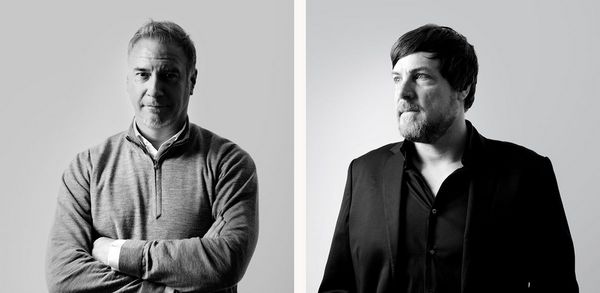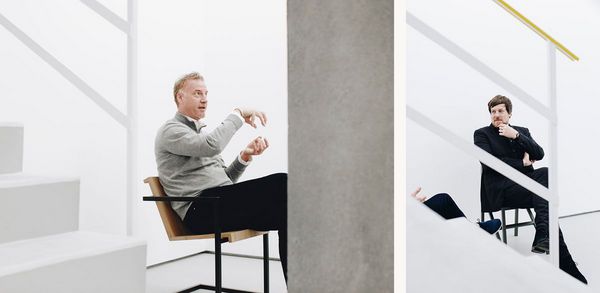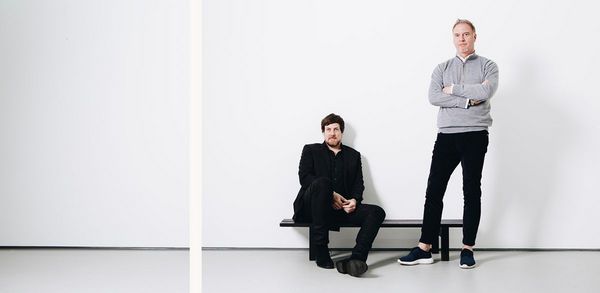
When Aston Martin met Gaggenau: a conversation
Aston Martin and Gaggenau are both brands driven by the desire to push beyond the usual boundaries of either British motoring or German engineering. The two men responsible for the creative direction of each brand sit down with Gaggenau to discuss the art of provoking desire and thinking outside the box
Words Sophie Cecil
Photography Hamish Stephenson

Aston Martin and Gaggenau have a certain chemistry between them. Both have distinctive, sleek aesthetics that stand out as the most elegant in their field. Both offer innovative products that represent best-in-class technical proficiency and both identify strongly with the in-built integrity of their heritage – of British motoring and German engineering respectively. These two brands may design and craft very different things, but they share many passions, experiences and aims in common.
Sven Baacke, Head of Design & Art Direction Global Brand Gaggenau, invited Marek Reichman, Vice President and Chief Creative Officer of Aston Martin, to join us for a few rare, quiet moments in a contemporary gallery space in East London, to discuss inspiration, creativity, and collaboration.


Gaggenau: Sven, how does Gaggenau identify with Aston Martin in terms of design?
Sven Baacke: For both brands it’s about beautiful machines: to be on the road, on one hand, or to cook on the other. But it’s about much more than that in both cases …
Marek Reichman: Exactly, we are both in industries of culture. And I don’t mean culture in terms of art, I mean culture in terms of tribes. It’s about wanting to be part of something, and it’s about us enabling you to become better; more like a racing car driver or a head chef. We can help you with the gear you need.
SB: For both of us, this is not just aesthetics. You ask ‘is it beautiful?’ but then also, and more often, ‘does it work?’
MR: Exactly. You might have a design ethos – as I do – which is to create beautiful things that reach beyond gender or age. But beauty goes well beyond just the aesthetic here. Because if you have something that is beautiful but doesn’t work, then you are more annoyed than anything.
SB: Yes, you have to make it work and still make it elegant. It’s a holistic approach where you have to dance between the technical restrictions.

‘You can stand in front of this appliance and admire it but also turn the key and be enabled to do something that you couldn’t do without it’

Gaggenau: How are you inspired by natural, organic shapes and materials vs geometry and synthetics?
SB: We at Gaggenau are more likely to pursue clean lines and geometric shapes. Rounded, organic forms are beautiful but not necessarily what you want to be surrounded by in your living environment. Take this gallery space – it’s so calm and ordered, this is a great space for new ideas. It feels good…
MR: Yes, and there’s a good example of geometry feeling good and natural in cars, too, which is the original 80-inch Land Rover. Its panels are so square it’s pretty much a square box, but it is one of the most beloved and recognised examples of car design – it is so honest. Nature is governed by mathematics, so geometry often does feel honest, right and natural.


Gaggenau: Do the engineers love you or hate you, Marek?
MR: [Laughs] Well, I admit that when I walk into a room of engineers there is usually a sigh, as they know I won’t accept that something isn’t achievable or that it’s impossible or that there is a mediocre answer. But I have a great relationship with our Chief Technical Officer (Max Szwaj) and we both understand the constraints that each party is working with. It’s about pull, and not push.
SB: It’s the same for us – and in fact I quite like it when an engineer comes to me and says ‘it can’t be done’ and I say, ‘OK, then how else can we do it?’ It leads to greater things.
MR: Exactly – an engineer is like a scientist; they go on a voyage of discovery by a series of steps, and they don’t know quite where they are going when they start. We as designers make a great leap at the start – we live by that saying: ‘if you can imagine it, then it is’. Imagination is what drives the Einsteins and the Da Vincis of the world. The ‘pull’ of the relationship is us designers bringing scientists on that journey and making it to the destination together.
SB: I also love to work with my hands and understand the materials better – to test and form them with mock-ups and models. We also do a lot of sketching by hand.


Gaggenau: Do you work by hand, day to day, Marek?
MR: Yes, I do. I always have. And we have learnt a very polished style of sketching in the car industry, as you often have to present and convince people that your design is worth investment – often many millions of pounds. I then work in clay to create models. Experimentation in 3D form is incredibly important. We will take materials to see how they perform in 3 dimensions, wrap them around and see how they move with the form. The modellers are really the unsung heroes of our industry – they look at how the light hits the surfaces and the form of something …
SB: Yes, light effects on a material’s surface; that’s very important.
MR: It is. We talk about ‘tension’ on the surface all the time. We want to give the impression that the surface has potential energy – that it wants to move, like a sprinter or a racehorse – and that process of discovery through modelling and experimentation is essential to that.
SB: When model makers are crafting things that you have imagined, I can be a bit like a child at Christmas, delighting at what is taking shape. In computer renderings you can’t see the proportions, you just can’t.
MR: It’s true. We have all these sophisticated CAD renderings and you can effectively create virtual cars – as we did for the video game Gran Turismo. It’s so accurate that you could effectively go and 3D print it. But we machined a model of that car and it needed work because it’s never right until you see it. I have such a strong belief that we need more than machines.

‘We want to give the impression that the surface has potential – that it wants to move, like a sprinter or a racehorse’

Gaggenau: How would you like your customers to feel about your designs?
MR: For me it’s that ‘ah!’ moment of wonder, a boy or a girl in a candy shop. That sharp intake of breath. The creation of desire. Some people say ‘I love my car’ and I do really want people to feel that way about Aston Martin cars – to have an emotional response and connection to it.
SB: Yes, it’s important for us at Gaggenau to make that emotional connection, too, as these appliances are what you live with, in your home, with your family. But also we want to inspire people to do something different the tools they have. Yes, you can stand in front of this appliance and admire it but also turn the key and be enabled to do something that you couldn’t do without it’ That’s a great feeling. It’s about creating something that can become a whole way of life.
